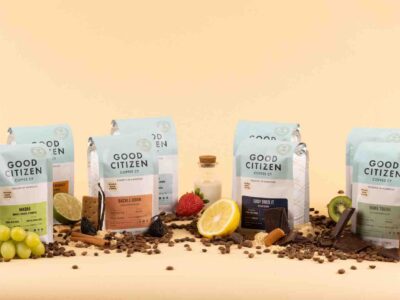Far North Spirits stand out amongst alcohol producers for several reasons. For one, it is the northernmost distillery in the continental U.S. Located in Hallock, MN — 25 miles from the Canadian border — it is famous for creating rye whiskey, gin, and rum with grains grown onsite.
The distillery was built on the Red River Valley Swanson Farm, and the distilling complex opened in 2013. Owner-operator Michael Swanson has overseen massive growth on the business end of things. He’s ushered in sustainable practices over the years.
A nifty aspect of Far North’s process is using the farm’s grain, which is stored in silos. All grains except malt barley are grown within a mile of the production site, saving money and carbon emissions from shipping and transportation. After distillation, spent grain is donated to local cattle farmers as animal feed or used for fertilizer.

Photo Courtesy Far North Spirits
Bees are critical for pollination and plant health, and Far North is a certified bee-friendly farm. According to the company, it is the first farm distillery to earn the designation from Pollinator Partnership. To celebrate Pollinator Week this past June, the company re-released a limited-edition limoncello. It’s made from local honey, with hives less than a mile from the farm.
“This certification means we are walking the talk,” Michael Swanson said about the pollinator certification. “We are being good stewards of the land and protecting it for generations to come.”
Water used for mashing grain is collected from the cooling system, siphoned into a steam-heated tank, and used for the next mash, saving energy that would go to heat the tank again.
Steam condensate is also collected to reduce water consumption. Cooling water is circulated in a closed-loop system. Being so far north, Far North says it doesn’t need anything more than evaporative cooling to chill water, saving even more energy.
Since most spirits are created in wood barrels, the distillery needs plenty. Local cooperages supply the business, decreasing transportation distances and costs. Far North also picks cooperages with responsible forestry practices.
The company says all grains grown are GMO-free, with corn only grown every two years to preserve soil health for rye. “This enables us to plant the corn field with a green manure cover crop then allow the soil to rest and digest the corn stalks,” the website explains. No rotation crops are needed to preserve soil health.

Photo Courtesy Far North Spirits
In addition, more than 600 trees are planted around the grounds to promote biodiversity and healthier vegetation. Native prairie plants act as buffer strips for rain runoff, control erosion rates, and serve as wildlife habitats and windbreaks. Wildflowers attract bees and pollinators. The wind is so strong that the Far North doesn’t need an air conditioner.
Shipping costs are much lower thanks to the local sourcing philosophy. Growing grains and sending them straight from the fields to the distillation house reduces emissions while making shipping more efficient.
According to the company, it takes one-sixth of the transportation energy to ship product from a Midwest farm distillery to a coastal retailer, as it does to move grain from the midwest to a distillery on a coast.
Where Far North made its name is utilizing rye for its spirits, standing out by providing rye classification. The business published a report with the University of Minnesota Crookston and the Minnesota Department of Agriculture. The study’s goal was to determine rye varieties used in whiskey production.
Most consumers aren’t aware of the type of rye that goes into the flavor of each whiskey. So Swanson and Prof. Jochum Wiersma worked together to make that distinction. They likened it to the way wine is categorized.
“Distillers often market things like lost and forgotten barrels, which creek the water trickled down, how grand-dad made it back in the day, and lately, which celebrity endorsed it,” the study explains. “Most don’t spend time discussing the actual base ingredients. This leaves many consumers unaware of which grain — let alone which variety — the spirit in their glass is actually made from.”

Photo Courtesy Far North Spirits
Swanson had grown AC Hazlet rye in 2012 because of its cold-weather durability, straw strength, disease resistance, and projected yield. In 2014, he used it in a whiskey batch after another farmer asked him about its taste. The Hazlet variety is rich in vanilla, pepper, and spice hints.
The study began in February 2015 and was completed in April 2021, opening a new door for the rye whiskey industry. With more data available, consumers can pick different lines of rye at the liquor store if they have a specific taste.
Swanson believes rye will establish Minnesota and other northern states as a new region for whiskey. “Historically, rye has been more of a northern crop,” Swanson said in an interview with “Minnesota Monthly.” “Bourbon is essentially Southern-made, and I think rye can be its Northern counterpart.”
“It’ll be interesting to see, over the next 10 years, how this develops — whether it’s a distinctive Minnesota style or a distinctive Minnesota ethos,” he continued. “If it all tastes the same, we failed. It should be radically different. Minnesota is radically different from one end to the other.”





